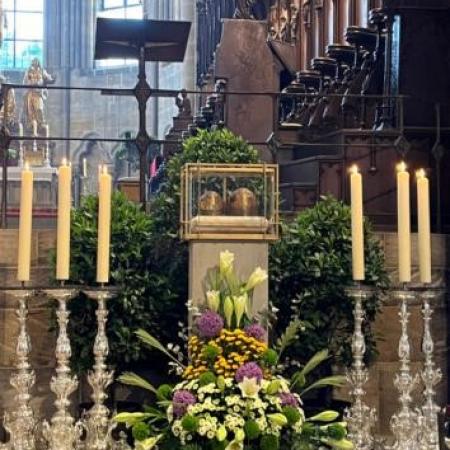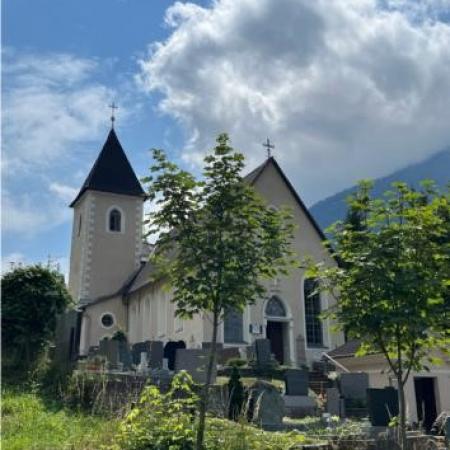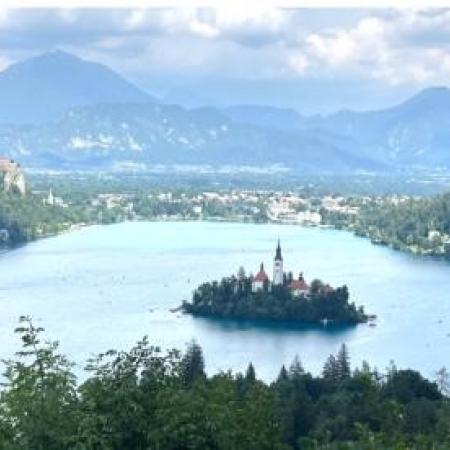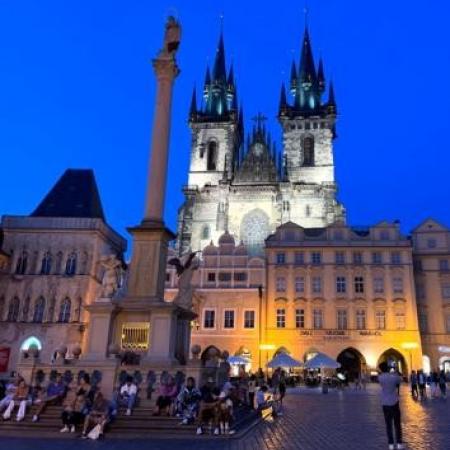Report: Hunting Saints, Experiencing History
For my DPhil thesis with the working title ‘Holy Couples in the Central and Later Middle Ages’, I am researching the cults of Catholic saints who were married to another saint between c. 1000– 1520. There are three such couples, the oldest of which are Emperor Henry II of Germany (died 1024, canonised 1146) and Cunigunde of Luxembourg (died 1033, canonised 1200). Their cults gained considerable traction in the later Middle Ages and spread from Bamberg, their most important cult centre, to various places throughout modern-day Bavaria, Switzerland, Austria, Slovenia, and the Czech Republic, as well as some places in Poland, the Netherlands, Belgium, and the Scandinavian countries. With the Gerry Grimstone Award I received, I spent just under four weeks this summer, 11th July to 5th August, travelling to a variety of places which had some connection to Henry, Cunigunde and/or their cults. The research for my thesis is mostly text-based, so while my travelling did not immediately contribute to my research, it overall served to develop my understanding of the medieval history and art history of different places and gain real-life impressions of cities I had only ever read about. It would have been impossible to attempt to visit all late medieval cult centres of Henry and Cunigunde in the course of just one journey, so I picked a representative selection, based on a logical travel route and a selection of cities of different sizes and in different countries.

I began my journey in Bamberg. The city and bishopric of Bamberg were founded by Henry, and he and Cunigunde are omnipresent there. In addition, I had timed my visit to coincide with the 1000th anniversary of Henry’s death on 13 July 1024. Since the mid-twelfth century, 13 July has been celebrated as his feast day. The celebrations began on Thursday night, when the skulls of Henry and Cunigunde (or rather, two skulls which are claimed to have belonged to the imperial couple), which are normally kept in the crypt of the cathedral of Bamberg, were processed around the cathedral, followed by a service honouring Henry. During the following few days, a major celebration took place throughout the city, centred around the two saints’ cults. Some highlights included a concert in the church of St James on Saturday evening, where a vocal ensemble sang 1,000-year-old Gregorian chants associated with Henry and Cunigunde; free entry into the museums of the city of Bamberg throughout the weekend; and a solemn mass on Sunday morning, celebrated by the archbishop of Bamberg. I stayed in Bamberg for the whole weekend, attended as many of the different events as I could, and took the time in between to extensively visit the different museums as well as Bamberg cathedral, where Henry and Cunigunde are buried in a splendid early-sixteenth-century marble tomb by the famous sculptor Tilman Riemenschneider. No other city in the world contains as many artworks, altars, relics, and other items associated with the medieval veneration of Henry and Cunigunde, and to see all of that – as well as the city and old town of Bamberg itself, which is one of very few German cities to have largely preserved its late medieval and early modern appearance – was a wonderful and highly enriching experience. All of this was set against the background of the twenty-first century celebration of the cult of two medieval saints. Despite the vastly different circumstances today, it was easy to imagine what the same celebration might have looked like several centuries ago.

After Bamberg, I travelled to Villach in Carinthia, Austria. I had long wondered why Carinthia, of all places, had developed a strong veneration of Henry and Cunigunde, but it became clear to me while I was there and visiting the local history museum. Henry gifted the town of Villach, together with large parts of Carinthia, to his newly founded bishopric of Bamberg in the early eleventh century, which caused a centuries-long, very close association between the two cities, and also led to the celebration of Henry and Cunigunde there, despite the considerable physical distance between Bamberg and Villach. I spent my first day in Villach getting to know the town and its history, as well as visiting its castle (which is now a residentiary building, despite its medieval origins), and its chapel, which is dedicated to Henry and Cunigunde. On the second day, I ventured into the Carinthian Alps. I took the bus to the tiny village Bleiberg-Kreuth and made my way up to the church St Henry. Founded in 1267, it is the oldest church in this Alpine valley. It is difficult to get to even today, and I found it absolutely fascinating that seven hundred fifty years ago, someone venerated the German emperor Henry enough to build a church in his honour in this place. On my way back, I enjoyed the stunningly beautiful Alpine landscape.

I travelled to Bled in Slovenia, which is only an hour on the train away from Villach. Bled, likewise situated in the Alpine foothills, is a small town at Lake Bled. The lake is overlooked on one side by a rocky mountain, on top of which is a medieval castle. Bled was gifted by Henry II to the bishop of Brixen, and like Villach, the connection with him and Cunigunde is visible everywhere. The castle, besides being wonderfully beautiful and allowing for an incredible view over Lake Bled, contains a historical museum describing life in medieval Slovenia. On my second day in Bled, I explored the lake itself. In addition to walking around the lake and enjoying the views, I took a boat to an island in the middle of the lake. There is a beautiful (originally medieval, now baroque) church on the island, where, to my surprise and delight, I came across statues of Henry and Cunigunde. Finally, on my third and last morning in Bled, I hiked through and admired the incredible beauty and natural wildness of Vintgar Gorge.

Overall, my journey took 26 days. I visited four countries and eight different towns or cities. It was a truly wonderful, transformative experience. While the medieval cults of Henry and Cunigunde framed my travelling and were the deciding factor for my choice of places to visit, I learned so much more than just about them. I learned about the interconnectedness of the medieval world – I spent many hours on an astounding variety of trains to get from place to place, yet eight hundred years ago, people carried the cults of Henry and Cunigunde from Bamberg to a remote village in the Austrian alps; to Lake Bled in Slovenia; to a tiny town outside Vienna; to the Bohemian city of Prague. At the same time, however, every single one of those places is unique. Every little village and town has its own distinct history, its own past connections and collective experiences which are still visible in today’s globalised world. All of this I knew in theory, from reading about it in books and seeing pictures on the internet – but travelling there, experiencing their history and culture for myself, was more valuable for me than months of studying. My journey truly changed my outlook on medieval history and modern Europe. I would like to express my deep gratitude to Lord Grimstone: without his generosity, this would never have been possible. Thank you.